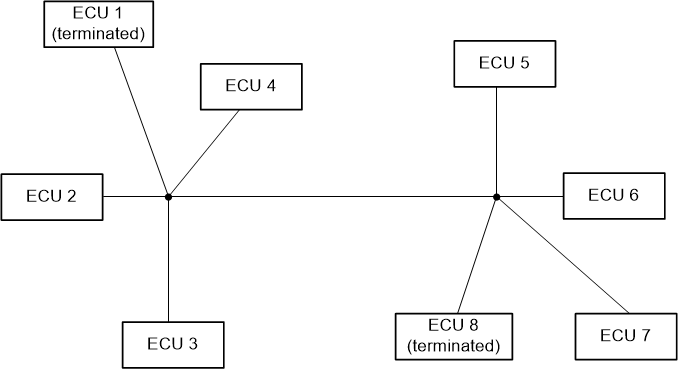JAJSUW7A June 2024 – December 2024 TCAN1472-Q1
PRODUCTION DATA
- 1
- 1 特長
- 2 アプリケーション
- 3 概要
- 4 Pin Configurations and Functions
- 5 Specifications
- 6 Parameter Measurement Information
-
7 Detailed Description
- 7.1 Overview
- 7.2 Functional Block Diagram
- 7.3 Feature Description
- 7.4 Device Functional Modes
- 8 Application and Implementation
- 9 Device and Documentation Support
- 10Revision History
- 11Mechanical, Packaging, and Orderable Information
パッケージ・オプション
メカニカル・データ(パッケージ|ピン)
サーマルパッド・メカニカル・データ
- DRB|8
発注情報
7.1.1 Signal Improvement
Signal improvement is an additional capability added to CAN FD transceiver that enhances the maximum data rate achievable in complex star topologies by minimizing signal ringing. Signal ringing is the result of reflections caused by impedance mismatch at various points in a CAN network due to the nodes that act as stubs.
An example of a complex network is shown in Figure 7-1.
 Figure 7-1 CAN Network: Star topology
Figure 7-1 CAN Network: Star topologyRecessive-to-dominant signal edge is usually clean and driven by the transmitter. For a regular CAN FD transceiver, dominant-to-recessive edge is when the driver output impedance goes to approximately 60kΩ and signal reflected back experiences impedance mismatch which causes ringing. TCAN1472-Q1 resolves this issue by TX-based Signal improvement capability (SIC). The device continues to drive the bus recessive until tSIC_TX_base, so the reflections die down and the recessive bit is clean at sampling point. In the active recessive phase, transmitter output impedance is low (approximately 100Ω). After this phase is over and device goes to passive recessive phase, driver output impedance goes to high-Z. This phenomenon is explained with Figure 7-2.
For more information on the TI signal improvement technology and the compares with similar devices in market, please refer to the white paper How Signal Improvement Capability Unlocks the Real Potential of CAN-FD Transceivers.
 Figure 7-2 TX based SIC
Figure 7-2 TX based SIC